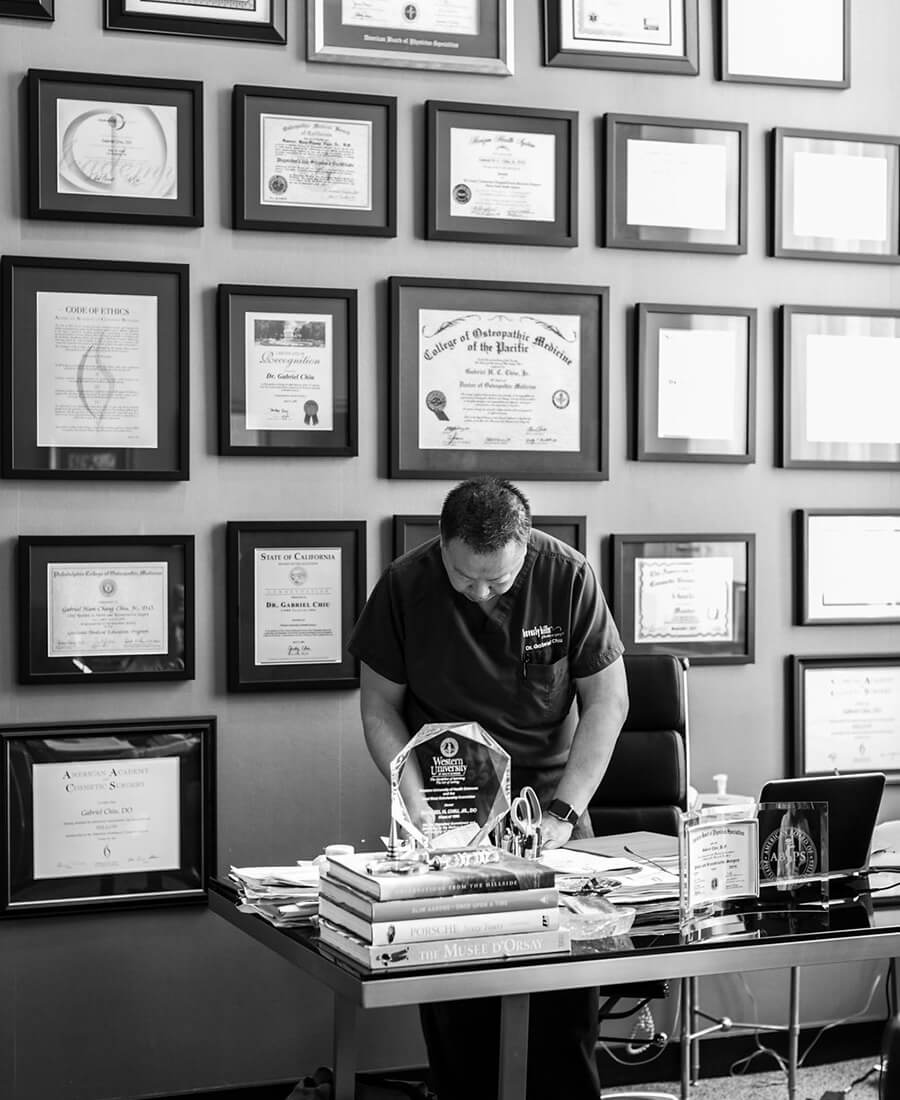Brow Lift in Beverly Hills, CA
Unveil Renewed Youth
The forehead is one of the first regions of the face to show signs of aging. Between routine sun exposure and the countless times you have raised your eyebrows, it is bound to begin wrinkling quickly. Even in their 30s, many people begin to notice cosmetic concerns such as drooping and permanent wrinkles. A brow lift targets precisely such concerns, crafting a newly alert and more youthful appearance for our patients in Beverly Hills.

Table of Contents
- What Is a Brow Lift?
- What Are the Benefits of a Brow Lift?
- Types of Brow Lifts
- Is a Brow Lift Right for Me?
- Overview of a Typical Forehead Lift Procedure
- Recovering from Your Brow Lift
- What Results Can I Expect From a Brow Lift?
- Results That Speak for Themselves
- Can You Combine a Forehead Lift With Other Procedures?
- Why choose Dr. Chiu?
- Frequently Asked Questions
What Is a Brow Lift?
Also called a forehead lift, a brow lift is a cosmetic surgery that addresses aging from the eyebrows to the hairline, namely wrinkles, deep furrows, and sagging eyebrows.
Typically performed as an outpatient procedure, brow lift surgery removes excess forehead skin, tightens the brow muscles, and advances the entire brow area to a youthful position. Wrinkles are smoothed away, and the skin’s texture becomes tighter and more consistent.
If a heavy brow is causing droopiness, then patients can see particularly stunning results that add a new, youthful expression to their eyes. Dr. Chiu’s techniques deliver natural-looking results so patients can enjoy a refreshed appearance without looking like they had work done.


What Are the Benefits of a Brow Lift?
• Eliminate skin laxity and brow ptosis
• Tighten a heavy or sagging brow
• Lift forehead tissues
• Long-lasting results
• Impart a more alert expression to the eyes
• Smooth away frown lines and forehead wrinkles
• Create a rested appearance
Types of Brow Lifts
Dr. Chiu utilizes a select few specialized brow lift techniques. He further adapts elements of each approach to match your individual needs, tailoring every aspect of your procedure plan.
Lateral or Temporal Brow Lift
This very popular brow lift technique will raise and change the angle of the lateral brows as well as eliminate sagging, drooping, and wrinkles from the corners of the eyes to the temporal hairline. This less invasive approach focuses on elevating the lateral, or outer, region of the face, from the top of the cheekbone to the outer corners of the eyebrows, without changing the central brows to avoid a surprised look or abnormal brow elevation.
Dr. Chiu makes tiny incisions in the hairline near the temple, allowing for a rejuvenating lift with discreet scarring. The results are natural-looking and subtle without an overly done look.
Classic or Coronal Brow Lift
Uses a wider (coronal) incision that starts at about ear level and then moves along the top of the forehead. The incision is made behind the hairline to ensure any scarring is hidden (if you are balding, the position will be adjusted).
This incision shape allows for the most significant amount of tightening and access to the underlying tissues. After removing excess skin and fat, Dr. Chiu lifts and repositions the forehead to a higher level. The skin is tightened, and the brows may be lifted to give a more open-eyed look.
Endoscopic Brow Lift
This technique uses smaller incisions (about four or five total) along the hairline. A small camera device is inserted through the incision to provide Dr. Chiu with a visual of the underlying tissues and muscles. He then lifts the forehead and adjusts the muscles accordingly for a smoother appearance.
The changes accomplished with this technique are milder, making it optimal for patients with moderate signs of aging.
Is a Brow Lift Right for Me?
Dr. Chiu offers several options for brow lifting techniques, allowing a wider range of patients to be suitable candidates for the procedure. He takes the time to go over each of your options, working to match you with the right procedure for your needs. Even if a brow lift is not your solution, he may recommend non-surgical treatments that can provide impressive results without invasive techniques.
If you want to see renewed facial expressions and a youthful look, you may be a candidate for a brow lift. Common qualities for candidates include:
- Age between 40 and 60 years (flexible range with adapted techniques)
- Be in overall good health
- Have healthy expectations and approach to surgery
- Be nonsmoking for 2 months before the procedure

Overview of a Typical Forehead Lift Procedure
Initial Consultation
The consultation is key to ensuring you are matched with the right procedure. Dr. Chiu strives to create a welcoming and understanding environment for each consultation. Common elements of a successful consultation include:
- Going over your medical history
- Openly discussing your goals
- Going through before-and-after photos
- Asking any questions you might have
Preparing for the Procedure
The days leading up to your brow lift involve a few preparation steps. Each one is easy to do, but they make a big difference in improving the safety and outcomes of your procedure. These include:
- Temporarily stop using certain medications
- Obtain any blood tests as instructed
- Treat any skin inflammation or infections on the forehead
- Avoid using tobacco products
Day of the Procedure
- Duration: Average of about 1–2 hours (combined surgery is longer). We will inform you ahead of time what to expect based on your procedure plan.
- Anesthesia: General anesthesia to ensure a painless experience. We work with a fully accredited surgery center and board-certified anesthesiologists for maximum patient safety.
- Incisions: Size and placement vary, but they are always hidden, often behind the hairline.
- Wrapping Up: Once incisions are closed and you are rested, you can return home the same day.
Recovering from Your Brow Lift
The recovery timeline can vary for each patient, varying with factors like age, natural recovery speed, and complexity of the surgery. Dr. Chiu will provide you with a personalized timeline during your consultation based on these factors. However, a general outline can include:
The First Week
Focus on resting at home and take time off from work and all activities. Discomfort, bruising, and swelling are normal, but with proper care, they will gradually fade. Keep your head elevated for the first few days to minimize swelling. Avoid any physical activity for the first couple of days. Most endoscopic brow lift patients will be ready to return to work by the end of the week.
The Second Week
Some patients may return to work, but others may still want to stay home for a few days this week. However, by the end of the second week, most swelling and bruising should have resolved. Feeling a bit tired is normal, but your energy should return as you continue to heal.
Third to Fourth Weeks
Though most visible signs of surgery should fade, continue care for the surgical sites as instructed. Continue to avoid strenuous activity until fully healed.
Beyond
Dr. Chiu sees all patients for follow-up visits to ensure their healing is going smoothly. He can add additional instructions or let you know when to return to your routine as applicable.
What Results Can I Expect From a Brow Lift?
Brow lift results are long-lasting, particularly when patients maintain healthy skincare and lifestyle habits.
The excess skin and fat are permanently removed, allowing for a youthful expression that lasts for years. While aging can continue, some ways to help prolong your forehead lift results beyond the average of 10+ years include:
- Avoiding sun damage and excess sun exposure
- Using high-quality sunscreen when outdoors
- Having a healthy skincare routine
- Avoiding habits that age your skin (e.g., smoking)

Can You Combine a Forehead Lift With Other Procedures?
Certainly! Many patients combine other facial procedures into a single visit. This way, you can avoid multiple recovery periods while seeing results that highlight each other. Popular combinations with a brow lift procedure include:
- Facelift
- Eyelid surgery
- Cheek lift
- Neck lift

Why choose Dr. Chiu?
Dr. Chiu is a board-certified plastic surgeon who has been a leader in the field for years in Los Angeles.
He approaches each procedure with the same high level of dedication, crafting tailored plans that incorporate the distinct preferences and needs of each patient.
Frequently Asked Questions
How much does a brow lift cost in Beverly Hills?
The cost of a brow lift can vary depending on a variety of factors, including your surgeon’s expertise, anesthesia and facility fees, surgical technique, and more. The best way to determine how much your brow lift will cost is to schedule a consultation.
How painful is a brow lift?
Anesthesia is used during the procedure for a painless patient experience. After the procedure, you may experience bruising, swelling, and discomfort. Dr. Chiu will provide you with aftercare instructions that cover how to care for any side effects.
Can a brow lift fix hooded eyes?
Yes, a brow lift can address hooded eyes, depending on the cause. If this issue is caused by skin laxity or brow ptosis, a brow lift can open up the eye area and improve hooded eyes. At a consultation, Dr. Chiu can help you determine how to best address your concerns and achieve your desired results.
How long do brow lifts last?
The results of your brow lift could last several years to a lifetime. This depends on the expertise of your surgeon, your unique anatomy, and your lifestyle and self-care after the procedure.
What is the difference between a brow lift and blepharoplasty?
A brow lift addresses the forehead, while a blepharoplasty (eyelid surgery) focuses on the skin of the upper and lower eyelids. Both of these cosmetic procedures can be combined for comprehensive upper face and forehead rejuvenation and a youthful, rested appearance.
Book Your Consultation
Dr. Chiu is proud to perform a brow lift near you for patients in Beverly Hills and the surrounding areas. Start your journey toward seeing a stark elimination of signs of aging when you schedule a consultation for a brow lift at Beverly Hills Plastic Surgery®. Call our office at (310) 888-8087, or use our online form to take that first step and begin working with a board-certified surgeon who combines experience with a refined eye for aesthetics.
Patient Reviews
J
Being a patient at BHPS has been an amazing experience. Everyone here has been extremely sweet and welcoming. The whole process from beginning to end has been very pleasant and I am happy that I decided to get my “girls” here. I have already started recommending you guys!
Julianna
Beverly Hills Plastic Surgery® is awesome! I had my breast augmentation done with Dr. Chiu, and just after a week I was driving and felt physically great! I have very natural results; my friends and family love it and told me that my new “friends” can’t look any better!…
Kelly
I would first like to thank all the staff at Beverly Hills Plastic Surgery®: Dr. Chiu, Chammy, Suzy, and Mallory. I appreciate everyone’s professionalism, accommodation, and kindness throughout my breast augmentation. I found Dr. Chiu through a Google search for top plastic surgeons in the area…
Aliaksandra
Dear Dr. Chiu, You are an amazing, skilled and talented surgeon. Truly, I feel blessed to have been your patient. From my initial consultation up until today, you have been warm, genuine, caring and professional. What I appreciate most is the time you took to guide me through the process of planning my breast augmentation…
Lisa
Dr. Chiu and his staff are the absolute best! My consultation was done thoroughly and he made sure to answer all my questions and let me know that he was there for me if I needed anything else. Every followup appointment, Dr. Chiu and his staff made me feel at home, I’d highly recommend him to anybody who is interested in pursing a cosmetic procedure!
Ariel
Dr. Chiu and his staff have been more than amazing to work with. The surgery process was effortless and I felt fully prepared for everything. I am more than happy with the results and Dr. Chiu and his team was with me every step of the way. Dr Chiu is very professional and I never once felt uncomfortable…


